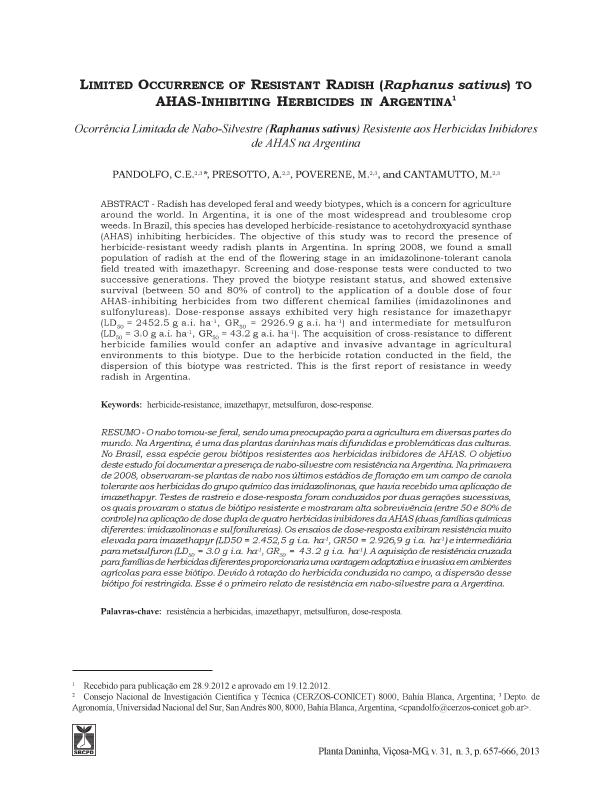Artículo
Radish has developed feral and weedy biotypes, which is a concern for agriculture around the world. In Argentina, it is one of the most widespread and troublesome crop weeds. In Brazil, this species has developed herbicide-resistance to acetohydroxyacid synthase (AHAS) inhibiting herbicides. The objective of this study was to record the presence of herbicide-resistant weedy radish plants in Argentina. In spring 2008, we found a small population of radish at the end of the flowering stage in an imidazolinone-tolerant canola field treated with imazethapyr. Screening and dose-response tests were conducted to two successive generations. They proved the biotype resistant status, and showed extensive survival (between 50 and 80% of control) to the application of a double dose of four AHAS‑inhibiting herbicides from two different chemical families (imidazolinones and sulfonylureas). Dose-response assays exhibited very high resistance for imazethapyr (LD50 = 2452.5 g a.i. ha-1, GR50 = 2926.9 g a.i. ha-1) and intermediate for metsulfuron (LD50 = 3.0 g a.i. ha-1, GR50 = 43.2 g a.i. ha-1). The acquisition of cross-resistance to different herbicide families would confer an adaptive and invasive advantage in agricultural environments to this biotype. Due to the herbicide rotation conducted in the field, the dispersion of this biotype was restricted. This is the first report of resistance in weedy radish in Argentina. O nabo tornou-se feral, sendo uma preocupação para a agricultura em diversas partes do mundo. Na Argentina, é uma das plantas daninhas mais difundidas e problemáticas das culturas. No Brasil, essa espécie gerou biótipos resistentes aos herbicidas inibidores de AHAS. O objetivo deste estudo foi documentar a presença de nabo-silvestre com resistência na Argentina. Na primavera de 2008, observaram-se plantas de nabo nos últimos estádios de floração em um campo de canola tolerante aos herbicidas do grupo químico das imidazolinonas, que havia recebido uma aplicação de imazethapyr. Testes de rastreio e dose-resposta foram conduzidos por duas gerações sucessivas, os quais provaram o status de biótipo resistente e mostraram alta sobrevivência (entre 50 e 80% de controle) na aplicação de dose dupla de quatro herbicidas inibidores da AHAS (duas famílias químicas diferentes: imidazolinonas e sulfonilureias). Os ensaios de dose-resposta exibiram resistência muito elevada para imazethapyr (LD50 = 2.452,5 g i.a. ha-1, GR50 = 2.926,9 g i.a. ha-1) e intermediária para metsulfuron (LD50 = 3.0 g i.a. ha-1, GR50 = 43.2 g i.a. ha-1). A aquisição de resistência cruzada para famílias de herbicidas diferentes proporcionaria uma vantagem adaptativa e invasiva em ambientes agrícolas para esse biótipo. Devido à rotação do herbicida conduzida no campo, a dispersão desse biótipo foi restringida. Esse é o primeiro relato de resistência em nabo-silvestre para a Argentina.
Limited occurrence of resistant radish (Raphanus sativus) to AHAS-inhibiting herbicides in Argentina
Título:
Ocorrência Limitada de Nabo-Silvestre (Raphanus sativus) Resistente aos Herbicidas Inibidores de AHAS na Argentina
Pandolfo, Claudio Ezequiel ; Presotto, Alejandro Daniel
; Presotto, Alejandro Daniel ; Poverene, Maria Monica
; Poverene, Maria Monica ; Cantamutto, Miguel Ángel
; Cantamutto, Miguel Ángel
 ; Presotto, Alejandro Daniel
; Presotto, Alejandro Daniel ; Poverene, Maria Monica
; Poverene, Maria Monica ; Cantamutto, Miguel Ángel
; Cantamutto, Miguel Ángel
Fecha de publicación:
07/2013
Editorial:
Universidade Federal Vicosa. Sociedade de Investigacoes Florestais
Revista:
Planta Daninha
ISSN:
0100-8358
Idioma:
Inglés
Tipo de recurso:
Artículo publicado
Clasificación temática:
Resumen
Palabras clave:
DOSE-RESPONSE
,
HERBICIDE-RESISTANCE
,
IMAZETHAPYR
,
METSULFURON
Archivos asociados
Licencia
Identificadores
Colecciones
Articulos(CCT - BAHIA BLANCA)
Articulos de CTRO.CIENTIFICO TECNOL.CONICET - BAHIA BLANCA
Articulos de CTRO.CIENTIFICO TECNOL.CONICET - BAHIA BLANCA
Articulos(CERZOS)
Articulos de CENTRO REC.NAT.RENOVABLES DE ZONA SEMIARIDA(I)
Articulos de CENTRO REC.NAT.RENOVABLES DE ZONA SEMIARIDA(I)
Citación
Pandolfo, Claudio Ezequiel; Presotto, Alejandro Daniel; Poverene, Maria Monica; Cantamutto, Miguel Ángel; Limited occurrence of resistant radish (Raphanus sativus) to AHAS-inhibiting herbicides in Argentina; Universidade Federal Vicosa. Sociedade de Investigacoes Florestais; Planta Daninha; 31; 3; 7-2013; 657-666
Compartir
Altmétricas



